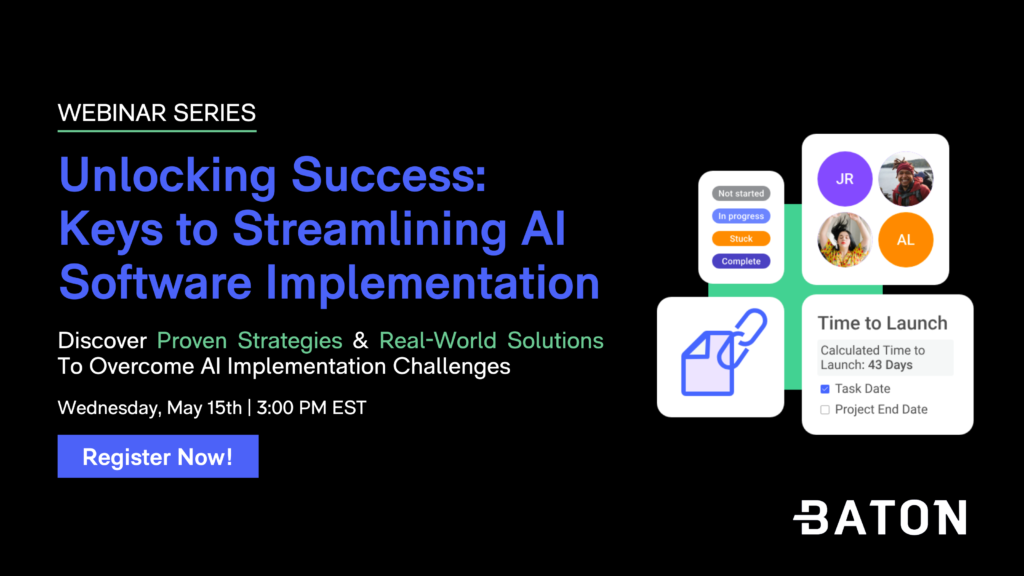AI technology has revolutionized countless industries, from healthcare to finance, by providing powerful tools for data analysis, automation, and decision-making. However, the success of AI software implementations depends not just on the technology itself, but also on how effectively it is implemented and onboarded by customers. In this blog, we’ll explore the 10 best practices AI software providers can utilize to ensure success in crafting a software implementation and customer onboarding project plan.
1. Conduct a Comprehensive Project Discovery Phase
Before diving into implementation, it’s crucial to conduct a thorough project discovery phase. This involves understanding the customer’s business goals, existing infrastructure, data sources, and potential challenges. Engage with key stakeholders to gather requirements, identify pain points, and define success criteria. This initial phase sets the foundation for a successful implementation by aligning expectations and uncovering any potential roadblocks early on.
2. Develop a Detailed Implementation Project Plan
Based on the insights gathered during the discovery phase, develop a detailed project plan outlining milestones, timelines, resource allocation, and responsibilities. Break down the implementation process into manageable phases, ensuring clear communication and alignment with the customer throughout. A well-defined project plan sets expectations, keeps the team accountable, and helps manage risks effectively.
3. Organize Asset Collection and Management
Effective asset collection and management are crucial for a smooth implementation. Ensure that all required data, documentation, and resources are organized, accessible, and up to date. Establish protocols for version control, data security, and compliance to avoid any disruptions during the implementation process. Centralized asset management streamlines collaboration and ensures that everyone is working with the latest information.
4. Customize Solutions and Project Plans to Meet Unique Customer Needs
While AI software solutions may offer a range of features and functionalities, customization to meet specific customer needs is key to success. Work closely with customers to understand their unique requirements and tailor the software accordingly. Provide flexibility for customization, integrations with existing systems, and scalability to accommodate future growth. A personalized approach enhances customer satisfaction and adoption rates.
5. Provide Comprehensive Training and Support
Effective training and support are essential for successful customer onboarding. Develop comprehensive training materials, workshops, and documentation to educate users on how to use the AI software effectively. Offer hands-on training sessions, webinars, and access to knowledgeable support staff to address any questions or issues. Empowering customers with the knowledge and resources they need fosters confidence and adoption.
6. Foster Collaboration and Open Communication
Effective collaboration and communication are fundamental throughout the implementation and onboarding process. Establish regular check-ins, status updates, and feedback sessions to keep stakeholders informed and engaged. Leverage collaboration tools, project management platforms, and communication channels to facilitate seamless interaction and transparency. Open lines of communication build trust and promote a collaborative environment.
7. Implement Quality Assurance and Testing
Quality assurance and testing are critical to ensure the reliability, accuracy, and performance of AI software solutions. Develop rigorous testing protocols, including functional testing, integration testing, and user acceptance testing (UAT), to identify and address any issues proactively. Conduct thorough QA reviews, performance tuning, and validation to deliver a robust and reliable product to customers. Continuous testing and feedback loops enhance software quality and customer satisfaction.
8. Monitor Performance and Measure Success Metrics
Post-implementation, continuously monitor the performance of AI software solutions and measure success metrics against predefined KPIs and benchmarks. Use analytics, dashboards, and reporting tools to track usage, performance, ROI, and customer feedback. Analyze data insights to identify areas for improvement, optimize workflows, and drive continuous innovation. Regular performance monitoring and measurement ensure ongoing success and customer satisfaction.
9. Enable Seamless Integration and Scalability
AI software implementations should seamlessly integrate with existing systems and workflows to maximize efficiency and ROI. Ensure compatibility with common platforms, APIs, and data sources to facilitate smooth data exchange and interoperability. Design solutions with scalability in mind to accommodate evolving business needs, increased data volumes, and growing user bases. Scalable and interoperable solutions provide long-term value and flexibility for customers.
10. Utilize Purpose-Built Implementation Management Solutions
Lastly, leverage purpose-built implementation management solutions and tools to streamline and automate project workflows. Use project management software, task tracking systems, and collaboration platforms to centralize communication, manage tasks, and track progress. Incorporate AI-driven analytics and automation capabilities to optimize resource allocation, identify bottlenecks, and improve project efficiency. Purpose-built tools enhance productivity, transparency, and project success.
Unlocking Excellence: The Essential Strategies for AI Software Implementation Triumph
In conclusion, successful AI software implementation and customer onboarding require a strategic approach, effective collaboration, and continuous improvement. By following these 10 best practices, AI technology software providers can ensure a positive discovery phase, organized asset collection and management, and the utilization of purpose-built implementation management solutions. This results in successful implementations, satisfied customers, and long-term success in the rapidly evolving AI landscape.
Ready to Dive into AI Implementation Success?
Discover proven strategies to navigate AI implementation complexities and conquer common challenges!




